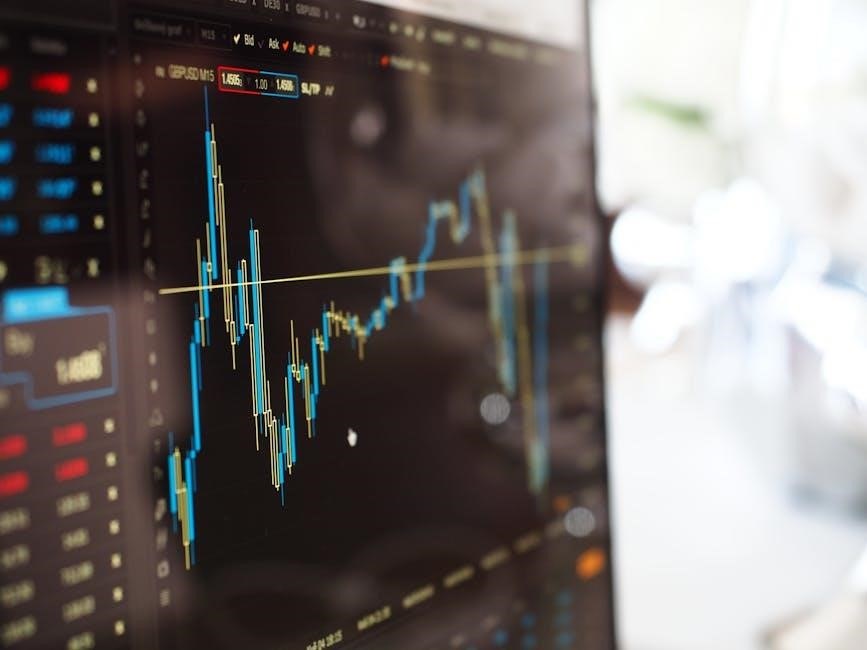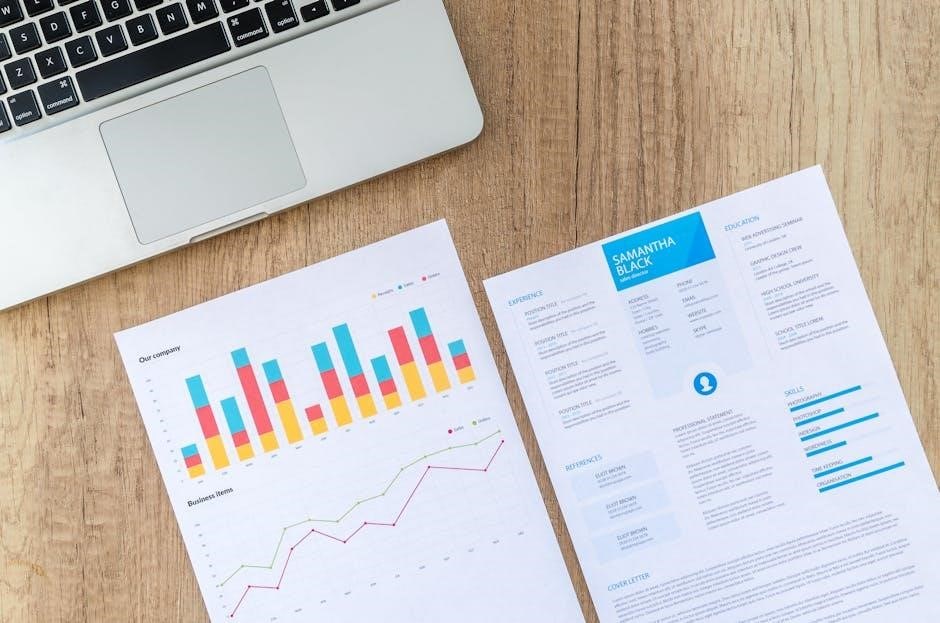Python simplifies data analysis, especially with PDFs, offering powerful libraries like PyPDF2 and PyMuPDF for extracting and processing data efficiently․
Its flexibility and extensive tools make it ideal for handling complex PDF structures, ensuring seamless data extraction and analysis workflows․
This introduction sets the stage for exploring Python’s capabilities in PDF data analysis, providing a foundation for the detailed techniques covered later․
1․1․ Why Use Python for Data Analysis?
Python is a powerful and versatile language for data analysis due to its simplicity and flexibility․ Its extensive libraries, such as Pandas and NumPy, streamline data manipulation and computation, making it ideal for handling complex datasets․ Additionally, Python’s ability to integrate with tools like PyPDF2 and PyMuPDF allows for efficient extraction and processing of data from PDFs, a common format in academic and professional settings․ The language’s intuitive syntax and active community support ensure rapid development and adaptability, making Python a preferred choice for both beginners and experts in data analysis tasks․
Python’s integration with visualization libraries like Matplotlib and Seaborn further enhances its utility, enabling users to present insights effectively․ Its scalability and compatibility with various data formats, including PDFs, solidify its position as a cornerstone in modern data analysis workflows;
1․2․ Key Libraries for Data Analysis in Python
Python’s data analysis capabilities are bolstered by essential libraries such as Pandas, NumPy, and Matplotlib․ Pandas excels in data manipulation and analysis, offering data structures like DataFrames for efficient data handling․ NumPy provides support for large, multi-dimensional arrays and matrices, enabling numerical computing․ Matplotlib and Seaborn are indispensable for data visualization, helping to transform insights into actionable graphs and charts․ Additionally, libraries like PyPDF2 and PyMuPDF are crucial for extracting data from PDFs, making Python a comprehensive tool for end-to-end data analysis workflows․
These libraries collectively empower users to perform tasks ranging from data extraction and cleaning to advanced visualization, ensuring Python’s dominance in data analysis․

Extracting Data from PDFs with Python
Python facilitates data extraction from PDFs, handling complex layouts and tables, ensuring accurate retrieval for analysis in various data analysis projects․
2․1․ Tools and Techniques for PDF Data Extraction
Python offers versatile tools like PyPDF2, PyMuPDF, and Tesseract-OCR for extracting data from PDFs․ These libraries enable text extraction, image recognition, and layout analysis, ensuring accurate data retrieval․
Techniques include leveraging regular expressions for structured data and optical character recognition for scanned documents․ These methods streamline data extraction, making it efficient for analysis․
Advanced approaches involve pre-processing scanned PDFs with OCR and handling multi-column layouts․ These tools and techniques are essential for managing complex PDF structures in data analysis workflows․
2․2․ Handling Different Types of PDFs
Python libraries like PyPDF2 and PyMuPDF excel at handling various PDF types, including text-based, image-based, and scanned documents․ For text-based PDFs, extracting data is straightforward using text extraction methods․ Image-based PDFs often require OCR tools like Tesseract for accurate data retrieval․ Scanned PDFs may need pre-processing to enhance text recognition․ Additionally, multi-column layouts and tabular data can be managed using regular expressions and custom parsing scripts․ Password-protected PDFs can be decrypted using libraries like PyPDF2․ These techniques ensure robust handling of diverse PDF formats, enabling efficient data extraction for analysis․

Data Cleaning and Preprocessing
Data cleaning involves removing duplicates, handling missing values, and standardizing formats․ Preprocessing ensures data quality and readiness for analysis, leveraging libraries like Pandas and NumPy for efficient manipulation․
3․1․ Best Practices for Data Cleaning
Effective data cleaning begins with identifying and addressing missing or corrupted data․ Use Python libraries like Pandas to detect missing values and handle them appropriately․
Standardize data formats to ensure consistency, and remove duplicates to prevent skewed analysis․ Regularly validate data types and formats to maintain integrity․
Document cleaning processes for transparency and reproducibility․ Leverage automated scripts for repetitive tasks to enhance efficiency and accuracy in data preparation․
3․2․ Handling Missing or Corrupted Data
When dealing with missing or corrupted data, identify the extent of the issue using Pandas’ isnull or isna functions to locate missing values․
Strategies include removing rows/columns with missing data using dropna or imputing values with mean/median using fillna․
For corrupted data, validate formats and types, and use regex or custom functions to clean inconsistent entries․
Advanced techniques involve predictive imputation using machine learning models or interpolation for time-series data․
Documenting these steps ensures transparency and reproducibility in your data analysis workflow․
Analyzing Data with Pandas and NumPy
Pandas and NumPy are foundational libraries for data analysis, enabling efficient manipulation and computation of numerical and structured data, essential for PDF-based data analysis workflows․
4․1; Basic Data Structures in Pandas
Pandas introduces two primary data structures: Series and DataFrames․ A Series is a one-dimensional labeled array, ideal for handling single columns of data, while a DataFrame is a two-dimensional structure resembling an Excel spreadsheet, with rows and columns․
DataFrames are particularly useful for storing and manipulating tabular data, such as that extracted from PDFs․ They support various data types and offer built-in methods for data manipulation, filtering, and analysis․
Understanding these structures is essential for efficiently processing and analyzing data in Python, especially when working with complex or unstructured data sources like PDF files․
These data structures form the backbone of data analysis workflows, enabling tasks like data cleaning, transformation, and visualization․
4․2․ Common Operations in NumPy and Pandas
NumPy and Pandas are cornerstone libraries for data analysis in Python․ NumPy excels at handling numerical operations, offering efficient array manipulation and mathematical computations․ Pandas, built on NumPy, extends this functionality to handle structured data, with operations like filtering, sorting, and grouping;
Common tasks include data merging, joining datasets, and performing statistical analyses․ These libraries also support data transformation, enabling the cleaning and preprocessing of data extracted from PDFs․ Understanding these operations is crucial for efficiently handling and analyzing data in Python, making them indispensable tools for any data analysis workflow․

Data Visualization with Matplotlib and Seaborn
Matplotlib and Seaborn are key libraries for creating visualizations in Python, enabling clear presentation of data insights, especially from PDF-extracted information, through charts, graphs, and heatmaps․
Matplotlib is a versatile Python library for creating high-quality 2D and 3D plots, essential for data visualization in Python․ It supports various plot types, including line charts, bar graphs, histograms, and scatter plots, making it ideal for presenting data insights clearly․ Whether you’re analyzing numerical data or visualizing trends from PDF-extracted information, Matplotlib provides precise control over plot customization․ Its ability to integrate with other libraries like Pandas and Seaborn enhances its functionality, allowing users to create informative and visually appealing graphs․ This library is a cornerstone in Python’s data analysis ecosystem, enabling effective communication of data-driven findings through visual representation․
5․2․ Advanced Visualization Techniques with Seaborn
Seaborn is a powerful Python library that extends Matplotlib, offering advanced visualization techniques for complex data analysis․ It provides elegant, high-level abstractions for creating informative and attractive statistical graphics․ With Seaborn, you can easily create heatmaps, pairplots, and violin plots to uncover deeper insights from your data․ Its integration with Pandas allows for seamless visualization of datasets, including those extracted from PDFs․ Seaborn’s customization options enable precise control over visual elements, ensuring clarity and effectiveness in communication․ By leveraging Seaborn’s advanced features, you can transform raw data into compelling visual stories, making it easier to identify patterns, trends, and correlations in your analysis․

Case Studies and Real-World Applications
Python’s tools enable efficient extraction of insights from PDFs, such as analyzing financial reports or academic papers, demonstrating its versatility in real-world data analysis scenarios․
6․1․ Examples of Python in Data Analysis Projects
Python’s versatility shines in various data analysis projects involving PDFs․ For instance, it’s widely used for extracting financial data from reports, analyzing academic papers, and processing business documents․ One notable example is its application in automating the extraction of tables and text from PDF-based research papers, enabling efficient data aggregation for meta-analyses․ Additionally, Python tools like PyPDF2 and PyMuPDF are instrumental in parsing large volumes of PDF documents, such as legal filings or medical records, to uncover patterns and insights․ These real-world applications highlight Python’s effectiveness in streamlining data extraction and analysis workflows, making it a cornerstone of modern data science․
As you advance, consider exploring advanced techniques for handling large-scale PDF datasets and integrating machine learning models for deeper analysis․ Continuously updating your skills and staying informed about new libraries will ensure you remain at the forefront of data analysis with Python․
